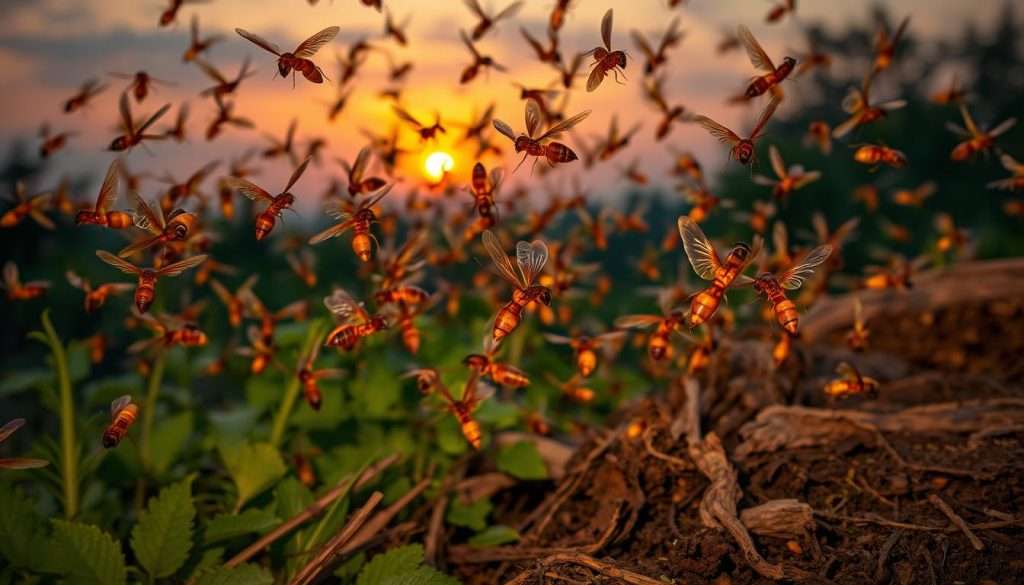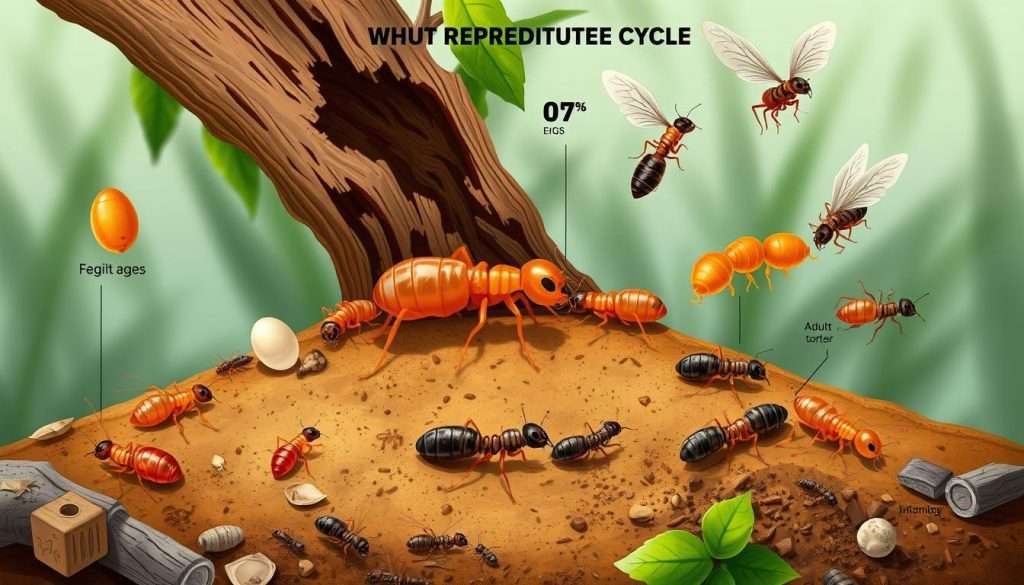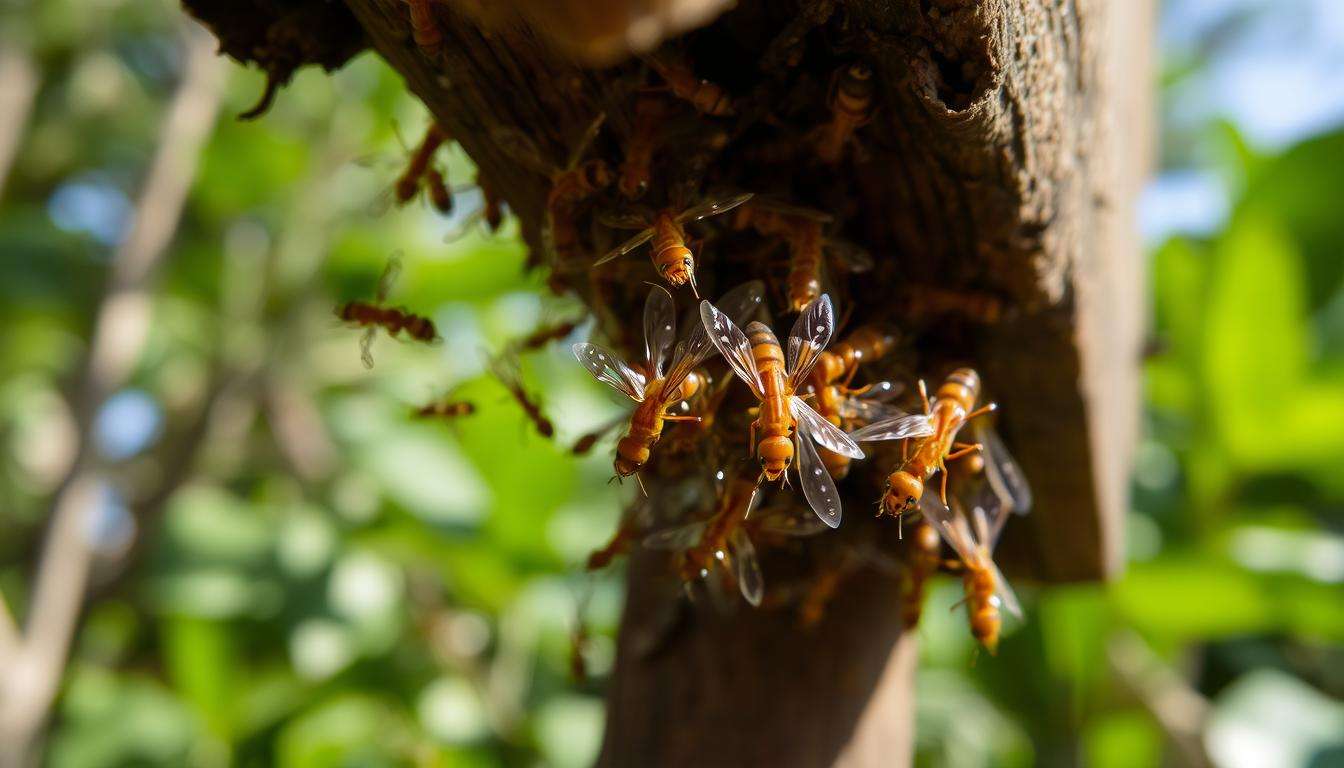Termite swarming is a key event in their life cycle. It shows they are ready to reproduce. Homeowners need to know why termites swarm to protect their homes. Swarming happens in warm, humid weather after rain.
This knowledge helps you prevent infestations. Understanding swarming’s timing and what it means is key.
When termites swarm, thousands of winged termites leave to mate and start new colonies. This event is short, lasting just a few minutes to an hour. It’s crucial to watch for signs of swarming to protect your home.
Look for discarded wings around windows or doors. Taking action quickly can save your home from damage and expensive repairs.
Key Takeaways
- Understanding why do termites swarm helps in implementing preventative measures.
- Termite swarming season typically occurs in spring, between March and May.
- Warm, humid conditions after rain trigger swarming behavior.
- Immediate action is crucial upon witnessing a swarm or finding discarded wings.
- Conducting annual inspections aids in early detection of infestations.
- Addressing moisture issues in and around the home is vital for prevention.
What is Termite Swarming?
Termite swarming is a key part of their life cycle. It happens when winged termites, called alates, leave their colonies. Knowing about termite swarming helps us understand how they spread.
Definition and Importance of Swarming
Termite swarming is all about making new termites and starting new colonies. During the swarming season, termites fly around in pairs. They do this mostly in the daytime, especially in spring.
Seeing these termites flying is a sign you might have an infestation. Homeowners need to act fast when they see this.
Timing and Conditions of Swarming Events
Swarming happens when the weather is just right. It usually happens after rain, on cloudy days with light winds. These conditions help the new termites survive as they look for new homes.
Subterranean termites, common in places like North Carolina, swarm in spring. Drywood termites swarm in late summer or early fall. Dampwood termites might swarm in summer.
Here is a table summarizing key features of termite swarming:
| Type of Termite | Swarming Season | Characteristics |
|---|---|---|
| Subterranean Termites | Spring | Large swarms, often in daylight, depend on moisture |
| Drywood Termites | Late Summer/Fall | Smaller swarms, up to 100 swarmers |
| Dampwood Termites | Summer | High moisture requirements, typically found in wood structures |

Why Do Termites Swarm
Termites swarm for a reason. It’s part of their life cycle. They need to keep their colonies growing. Moisture and temperature help them swarm.
Reproductive Cycle of Termites
Termites make swarmers when their colony is ready. They swarm during the day, mostly in spring. But they can swarm all year.
In places like Florida, termites swarm at different times. It takes a few years for a colony to make swarmers.
Environmental Triggers for Swarming
Moisture and temperature are important for termites. They need humidity to live. So, they swarm after it rains or when it’s warm and humid.
In North Carolina, termites love damp places. Swarming means there’s a colony nearby. This is bad news for homeowners.
Swarming Behavior and Its Implications
Termites swarming is a big deal for homeowners. When you see them, it means trouble. They might not survive inside because of dry air.
But their presence means a colony is close. This can cause a lot of damage. It’s important to call pest control right away. For more info, check this resource.

Types of Termites That Swarm
Knowing the different types of termites that swarm is key for homeowners. These termites can cause a lot of damage if not stopped early. Let’s look at three main types of termites known for swarming.
Subterranean Termites
Subterranean termites are known for their underground colonies. They need moisture, which makes them a big threat to wood. They swarm in the spring, from March to June, as part of their life cycle.
When they swarm, they do it in big groups outdoors. This makes it easy to see if termites are around.
Drywood Termites
Drywood termites live in the wood they eat. They swarm in the evening, usually in late summer or early fall. It’s important to spot them early to stop them.
Dampwood Termites
Dampwood termites love wet places. They swarm in late spring to early summer, when it’s humid. Spotting them early is key to prevent damage.
Knowing about these termites helps homeowners watch for signs of infestation. Catching them early can save a lot of damage.
| Type of Termite | Swarming Period | Habitat | Signs of Infestation |
|---|---|---|---|
| Subterranean Termites | March to June | Underground | Exit holes, mud tubes |
| Drywood Termites | Late Summer to Early Fall | Wood structures | Small exit holes, wood damage |
| Dampwood Termites | Late Spring to Early Summer | High-moisture areas | Wood damage, frass (wood feces) |
Signs of Termite Infestation and Swarming
It’s important for homeowners to know the signs of termite infestation. Sometimes, damage is visible only after it’s too late. Spotting termite swarmers early can save you from expensive repairs. Let’s look at how to identify swarmers and the signs of termite damage.
Identifying Termite Swarmers
Spotting termite swarmers is key to knowing you have an infestation. These winged insects show up in warm months, like spring and summer. Here are some important points:
- Swarmers are about ½ inch long with two pairs of white or translucent wings.
- They often gather near windows and doors, looking for a place to nest.
- Seeing hundreds indoors means you have an active infestation.
- Swarming happens when a termite colony is 2-3 years old.
Common Signs of Termite Damage
There are physical signs that show termite damage in your home:
- Pinhole openings in walls or ceilings mean you have an infestation.
- Sunken areas in wallpaper or paint can hide termite galleries.
- Odd-shaped mud formations on walls might be swarm castles by Formosan termites.
- Termite shelter tubes on foundational walls, especially higher up, are a clear sign.
- Small, six-sided pellets show drywood termite activity.
- Sagging floors or ceilings can mean structural damage from termites.
Knowing these signs helps you act fast if you find termites. This can stop big and expensive repairs later.
| Signs of Termite Infestation | What to Look For |
|---|---|
| Swarmers Indoors | Large groups of winged insects, indicating a serious colony. |
| Pinhole Openings | Tiny holes in walls or wood structures, an indicator of feeding. |
| Sunken Wallpaper | Areas in wallpaper that appear sunken can indicate hidden damage. |
| Mud Tubes | These tubes typically lead to the structure from underground nests. |
| Wood Damage | Hollow-sounding wood can denote substantial damage below the surface. |
Conclusion
Knowing how termites behave is key to keeping your home safe. Termites usually swarm in spring and summer. But, some might show up in fall if it’s warm.
Being ready for these times helps you act fast. Regular checks, especially during swarming seasons, catch problems early. This can save you from expensive damage.
Using good termite control methods is a must. Keep your home well-ventilated and fix any leaks. Also, store wood right and seal your home’s entry points.
Killing swarmers might seem like a fix, but it’s not enough. If worker termites are still inside, you’ll still have a problem. Call experts who know how to get rid of termites if you think you have an issue.
Learning how to stop termites helps protect your home. This guide gives you the knowledge and steps to keep termites away. For more info, check out this article.
